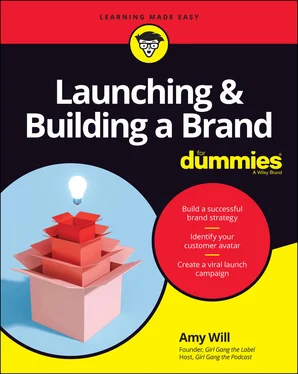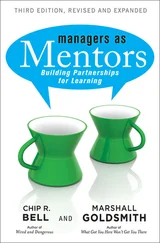Amy Will - Launching & Building a Brand For Dummies
Здесь есть возможность читать онлайн «Amy Will - Launching & Building a Brand For Dummies» — ознакомительный отрывок электронной книги совершенно бесплатно, а после прочтения отрывка купить полную версию. В некоторых случаях можно слушать аудио, скачать через торрент в формате fb2 и присутствует краткое содержание. Жанр: unrecognised, на английском языке. Описание произведения, (предисловие) а так же отзывы посетителей доступны на портале библиотеки ЛибКат.
- Название:Launching & Building a Brand For Dummies
- Автор:
- Жанр:
- Год:неизвестен
- ISBN:нет данных
- Рейтинг книги:5 / 5. Голосов: 1
-
Избранное:Добавить в избранное
- Отзывы:
-
Ваша оценка:
- 100
- 1
- 2
- 3
- 4
- 5
Launching & Building a Brand For Dummies: краткое содержание, описание и аннотация
Предлагаем к чтению аннотацию, описание, краткое содержание или предисловие (зависит от того, что написал сам автор книги «Launching & Building a Brand For Dummies»). Если вы не нашли необходимую информацию о книге — напишите в комментариях, мы постараемся отыскать её.
Launching & Building a Brand For Dummies,
Launching & Building a Brand For Dummies
Launching & Building a Brand For Dummies — читать онлайн ознакомительный отрывок
Ниже представлен текст книги, разбитый по страницам. Система сохранения места последней прочитанной страницы, позволяет с удобством читать онлайн бесплатно книгу «Launching & Building a Brand For Dummies», без необходимости каждый раз заново искать на чём Вы остановились. Поставьте закладку, и сможете в любой момент перейти на страницу, на которой закончили чтение.
Интервал:
Закладка:
Getting a license (or not)
Depending on the location and nature of your business, you may need to be licensed to conduct business in a certain jurisdiction. Rules vary among states, counties, and municipalities. In most states, freelancers such as writers, editors, and graphic artists don’t need a license to do business, but if you plan on opening a restaurant or bricks-and-mortar retail store, or if you’re a building contractor or insurance agent, you’ll need a license. Again, check with your local SBA or secretary of state to determine licensing requirements.
Getting a trademark, patent, or copyright
If you’re creating something unique, you need to do more than register your business; you also need to register your ideas to protect your intellectual-property rights. Depending on what your “something unique” is, obtain a copyright (for books and other publications), patent (for inventions), or trademark (for a business or brand name, logo, or design). You may need all three.
You can trademark, patent, or copyright your intellectual property yourself through the U.S. Patent and Trademark Office ( https://www.uspto.gov/trademarks ) or hire an attorney to do the job for you. You can find plenty of law firms online that offer intellectual-property legal services. Just search the web for “how to” followed by “trademark,” “patent,” or “copyright” to pull up a list.
 I cover this topic in greater detail in Chapter 19, but I mention it here because depending on your business and brand, it may be a crucial part of the getting-started process. You don’t want to come up with a multimillion-dollar idea only to have it stolen.
I cover this topic in greater detail in Chapter 19, but I mention it here because depending on your business and brand, it may be a crucial part of the getting-started process. You don’t want to come up with a multimillion-dollar idea only to have it stolen.
Financing Your Business/Brand
Depending on the business/brand you’re building and launching, you may be able to work with on a shoestring budget of your own money, or you may need to find additional sources of cash. If you’re creating a personal brand to promote yourself as the world’s leading expert on raising chickens, you can probably do that (or at least start) with a website, blog, and podcast, which don’t require much money. By contrast, if you’re aiming to create your own clothing line or build an international dog-grooming franchise, you’ll need to scrounge up the money by recruiting partners, borrowing money (from individuals or banks), or selling shares in your company to investors.
In this section, I introduce you to various sources of financing. But before you even think about exploring available financing options, create a budget so that you’ll know just how much money you’ll need.
Budgeting for your business/brand
To budget for your business/brand, create a list of everything you need to make it a success, research prices, and then add everything up. Table 2-1contains a list of items to get you started. Depending on the business/brand you’re creating, you may need to add to the list or cross off some items. When you have a comprehensive list, research the cost for each item/service (on the web or by calling around), and write the estimated cost in the right column.
TABLE 2-1Business/brand budget
| Item | Cost |
|---|---|
| Legal fees (for incorporation, registration, licenses, and intellectual-property protections) | |
| Accounting fees (if you plan to hire an accountant) | |
| Brand design (logo and graphics) | |
| Website/blog (design, build, and host) | |
| Marketing/advertising (online ads) | |
| Materials/equipment/supplies | |
| Manufacturing/product sourcing (if you’ll be selling an original product) | |
| Staff (if you’re planning to hire people) | |
| Rent (for a bricks-and-mortar business or retail store) |
CREATING A SELF-FUNDED BRAND
A self-funded brand isn’t one that funds itself, but one that you fund. The benefit of creating a self-funded brand is that you have total control of all business/brand decisions, and you get to keep 100 percent of the profits. Woo-hoo!
Unfortunately, the potential benefits are outnumbered by the drawbacks:
You’re responsible for all business/brand decisions.
You suffer 100 percent of any losses.
You have limited access to financing to fuel growth and pursue opportunities.
 If your plan is to sell a unique product you’re going to manufacture, that plan can get expensive fast. And unless you’re 100 percent certain that the product is going to sell like hotcakes, manufacturing thousands of units can pose a huge financial risk. To reduce the risk, consider launching a preorder campaign. Make a small batch, and wait till the orders come in to make larger quantities. The down sides to this strategy are that customers may have to wait longer to receive their orders, and you may have to pay more in manufacturing costs per item. This strategy is just a test run, however. You can go all in when you see how popular your product is.
If your plan is to sell a unique product you’re going to manufacture, that plan can get expensive fast. And unless you’re 100 percent certain that the product is going to sell like hotcakes, manufacturing thousands of units can pose a huge financial risk. To reduce the risk, consider launching a preorder campaign. Make a small batch, and wait till the orders come in to make larger quantities. The down sides to this strategy are that customers may have to wait longer to receive their orders, and you may have to pay more in manufacturing costs per item. This strategy is just a test run, however. You can go all in when you see how popular your product is.
Creating a business plan
When you’re seeking any type of financing for your business/brand, a business plan is essential. Nobody (except maybe your parents or your rich Aunt Matilda) will hand you money just because you ask for it. Banks, investors, and organizations want to know that their money will be put to good use. Banks want some assurance that your loan will be paid back. Investors want a reasonable expectation that they’ll receive a return on their investment.
If you don’t already have a business/brand in place to demonstrate a proven track record of success, you need a convincing business plan. Creating a business plan is beyond the scope of this book, but make sure that your plan contains the following key elements:
Summary: The summary should include what your business/brand is and does, and why it’s better than the competition; your bio and experience (and that of any partners or associates); the products/services you offer; and why you think your business/brand will be successful.
Strategy, goals, objectives, and activities: Your strategy is your big plan or idea of how you’re going to achieve success. Goals are what you need to accomplish to execute your strategy. Objectives are measurable milestones you must meet to reach your goals. And activities are what you’ll do to meet your objectives.
Market/competitive analysis: This analysis describes the industry or market and any existing competition, and shows how your brand is different from and better than what’s already available.
Financial projections: This element is your budget to start and run the business (costs), how much money you’re expecting to pull in (revenue), projected profit (revenue minus costs), and how you plan to pay back any loans or reward investors. Prepare for setbacks, unexpected costs, and missed goals to protect yourself from underdelivering. It’s best to set benchmarks that have a margin for error to make sure everyone involved can understand the full scope of the plan.
For detailed guidance on creating a business plan, check out Creating a Business Plan For Dummies, by Veechi Curtis (John Wiley & Sons, Inc.).
Getting grants
Depending on your business/brand, you may be able to get a grant to finance it. A grant is free money; you never have to pay it back! Organizations offer grants for all sorts of reasons, such as to stimulate the economy, improve communities, and empower certain demographics (such as women in business).
Читать дальшеИнтервал:
Закладка:
Похожие книги на «Launching & Building a Brand For Dummies»
Представляем Вашему вниманию похожие книги на «Launching & Building a Brand For Dummies» списком для выбора. Мы отобрали схожую по названию и смыслу литературу в надежде предоставить читателям больше вариантов отыскать новые, интересные, ещё непрочитанные произведения.
Обсуждение, отзывы о книге «Launching & Building a Brand For Dummies» и просто собственные мнения читателей. Оставьте ваши комментарии, напишите, что Вы думаете о произведении, его смысле или главных героях. Укажите что конкретно понравилось, а что нет, и почему Вы так считаете.












